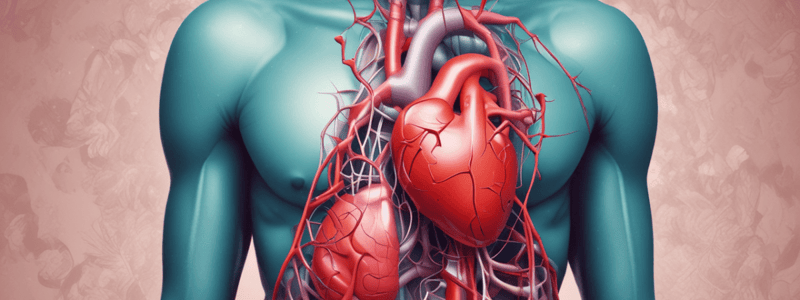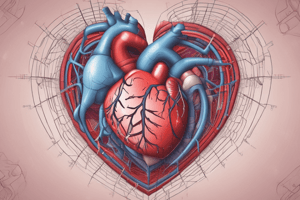Podcast
Questions and Answers
Which type of cardiomyopathy is commonly seen in felines?
Which type of cardiomyopathy is commonly seen in felines?
- Dilated cardiomyopathy
- Hypertrophic cardiomyopathy (correct)
- Left ventricular cardiomyopathy
- Restrictive cardiomyopathy
What is the primary consequence of congestive heart failure?
What is the primary consequence of congestive heart failure?
- Increased blood pressure
- Increased heart rate
- Inadequate pumping of blood by the heart (correct)
- Decreased blood volume
Which of the following is NOT a common clinical sign of congestive heart failure?
Which of the following is NOT a common clinical sign of congestive heart failure?
- Fever (correct)
- Weight loss
- Coughing
- Dyspnea
What is the primary action of positive inotropic agents?
What is the primary action of positive inotropic agents?
Which of the following is an antiarrhythmic drug?
Which of the following is an antiarrhythmic drug?
What is the primary mechanism of action of ACE inhibitors?
What is the primary mechanism of action of ACE inhibitors?
What is the primary action of potassium channel blockers?
What is the primary action of potassium channel blockers?
What is the effect of calcium channel blockers ?
What is the effect of calcium channel blockers ?
What is the primary function of the cardiovascular system?
What is the primary function of the cardiovascular system?
What is the term for the ventricular stretch at the end of diastole, just before contraction?
What is the term for the ventricular stretch at the end of diastole, just before contraction?
Which of the following is a compensatory mechanism in heart disease?
Which of the following is a compensatory mechanism in heart disease?
What is the term for a medication that increases the heart rate?
What is the term for a medication that increases the heart rate?
What is the term for the resistance the left ventricle experiences when it tries to eject blood
What is the term for the resistance the left ventricle experiences when it tries to eject blood
What is the term for a medication that increases the contraction force of the heart?
What is the term for a medication that increases the contraction force of the heart?
What is the term for a condition in which the heart is unable to pump enough blood to meet the body's needs?
What is the term for a condition in which the heart is unable to pump enough blood to meet the body's needs?
What is the primary goal of dietary management in heart failure?
What is the primary goal of dietary management in heart failure?
What is the effect of CCB on the heart?
What is the effect of CCB on the heart?
Which of the following vasodilator drugs reduces preload?
Which of the following vasodilator drugs reduces preload?
What is the primary action of diuretics?
What is the primary action of diuretics?
What is a common adverse effect of diuretic administration?
What is a common adverse effect of diuretic administration?
What is the primary goal of diuretic therapy in CHF?
What is the primary goal of diuretic therapy in CHF?
What is a crucial aspect of patient care when using diuretics?
What is a crucial aspect of patient care when using diuretics?
What is a common ancillary treatment for CHF?
What is a common ancillary treatment for CHF?
What is a key aspect of dietary management for CHF?
What is a key aspect of dietary management for CHF?
What is the primary effect of increased preload on the cardiac contraction?
What is the primary effect of increased preload on the cardiac contraction?
What is the result of a damaged ventricle in terms of cardiac output?
What is the result of a damaged ventricle in terms of cardiac output?
Which of the following is a compensatory mechanism to increase cardiac output?
Which of the following is a compensatory mechanism to increase cardiac output?
What is the effect of bradycardia on cardiac output?
What is the effect of bradycardia on cardiac output?
What is the effect of poor contractility on cardiac output?
What is the effect of poor contractility on cardiac output?
What is the primary function of the autonomic nervous system in regulating heart rate?
What is the primary function of the autonomic nervous system in regulating heart rate?
Which of the following increases as a result of tachycardia?
Which of the following increases as a result of tachycardia?
What is the direct consequence of increased afterload on the heart?
What is the direct consequence of increased afterload on the heart?
Which of the following is a compensatory mechanism in heart disease?
Which of the following is a compensatory mechanism in heart disease?
What is the primary determinant of cardiac output?
What is the primary determinant of cardiac output?
Which of the following is a result of decreased preload?
Which of the following is a result of decreased preload?
What is the primary function of the SA node in the cardiac conduction system?
What is the primary function of the SA node in the cardiac conduction system?
Positive inotropic agents
Positive inotropic agents
Positive inotropic agents
Positive inotropic agents
What is the basic function of the CV system
What is the basic function of the CV system
Each cell in the heart is capable of contracting spontaneously
Each cell in the heart is capable of contracting spontaneously
HR is controlled primarily by Somatic NS
HR is controlled primarily by Somatic NS
Cardiac output is the amount of blood pumped by the heart per hour
Cardiac output is the amount of blood pumped by the heart per hour
Preload is the ventricular stretch at the end of diastole
Preload is the ventricular stretch at the end of diastole
Afterload is the resistance in the right ventricle when ejecting blood out of the ventricle
Afterload is the resistance in the right ventricle when ejecting blood out of the ventricle
If the heart rate increases cardiac output increases and vice versa
If the heart rate increases cardiac output increases and vice versa
Abnormal heart rates can indicate which of the following
Abnormal heart rates can indicate which of the following
What happens to compensate for disease processes results in reduced diastolic period, reduced preload, and increased oxygen consumption.
What happens to compensate for disease processes results in reduced diastolic period, reduced preload, and increased oxygen consumption.
What is preload
What is preload
Pump dysfunction clinical signs
Pump dysfunction clinical signs
Pump dysfunction increases in the _______
Pump dysfunction increases in the _______
What is afterload
What is afterload
Damaged ventricles = in cardiac output
Damaged ventricles = in cardiac output
Clinical signs of damaged ventricles
Clinical signs of damaged ventricles
What is the terminology for the ability of the myocardium to contract
What is the terminology for the ability of the myocardium to contract
Compensatory mechanisms
Compensatory mechanisms
Common clinical signs of congestive heart failure
Common clinical signs of congestive heart failure
Irregular rhythm + increased rate = pathologic response called ?
Irregular rhythm + increased rate = pathologic response called ?
Force and rhythm
Force and rhythm
Categories of CV drugs (4)
Categories of CV drugs (4)
What is the main type of valvular disease seen in dogs
What is the main type of valvular disease seen in dogs
What are 4 heart diseases
What are 4 heart diseases
Positive inotropic drugs
Positive inotropic drugs
Classes of cardiovascular drugs
Classes of cardiovascular drugs
Drugs
Drugs
Drugs
Drugs
Factors that predispose the heart to arrhythmias (6)
Factors that predispose the heart to arrhythmias (6)
Result in reduced cardiac output by poorly coordinated pumping
Result in reduced cardiac output by poorly coordinated pumping
• CHF ACE Narrowing of blood vessels = __________
• CHF ACE Narrowing of blood vessels = __________
Ace inhibitors decrease the production of angiotensin II allowing for __________________________________________________________________________________________
Ace inhibitors decrease the production of angiotensin II allowing for __________________________________________________________________________________________
Inotropic mixed dilator
Inotropic mixed dilator
What is the loss of K+ due to increase urination
What is the loss of K+ due to increase urination
Two types of diuretics
Two types of diuretics
Vasodilator drugs
Vasodilator drugs
Classes of cardiovascular drugs: Action is dependent on the drug, fluid and electrolyte balance
Classes of cardiovascular drugs: Action is dependent on the drug, fluid and electrolyte balance
Classes of cardiovascular drugs: The drugs inhibit the activity of the enzyme ACE, decreasing the production or angiotensin II which allows for the blood vessels to dilate and blood pressure is reduced
Classes of cardiovascular drugs: The drugs inhibit the activity of the enzyme ACE, decreasing the production or angiotensin II which allows for the blood vessels to dilate and blood pressure is reduced
Results in reduced cardiac output by poorly coordinated pumping activity
Results in reduced cardiac output by poorly coordinated pumping activity
Flashcards are hidden until you start studying
Study Notes
Heart Disease
- Types of heart disease:
- Valvular disease (tricuspid valve, mitral valve)
- Cardiac arrhythmias
- Myocardial disease (hypertrophic cardiomyopathy, cardiomyopathy)
- Other: congenital defects, heartworm
Congestive Heart Failure
- Definition: Heart is incapable of pumping an adequate volume of blood
- Clinical signs:
- Pulmonary edema (fluid in the lungs)
- Ascites (fluid accumulation in abdomen and peripheral limbs)
- Coughing
- Syncope
- Weight loss
- Cyanosis
- Lethargy
- Dyspnea
- Difficulty exercising
Arrhythmias
- Definition: Irregular rhythm + increased rate = pathologic process
- Note: A sinus arrhythmia is an irregular rhythm that occurs at a low or normal heart rate
- Pulse deficits (or absence of a peripheral arterial pulse) may also be detected if the heart rate is irregular
Force & Rhythm
- Inotropic: alters force of muscle contractions
- Chronotropic: changes HR by changing rhythm
Categories of Cardiovascular Drugs
- Positive inotropic agents
- Antiarrhythmic agents
- Vasodilators
- Diuretics
Positive Inotropic Agents
- Stimulate the heart and increase the strength of cardiac muscle contractions
- Examples:
- Glycosides (e.g. Digoxin)
- Catecholamines (e.g. Dobutamine, Dopamine, Epinephrine)
- Benzimidazole pyridazinones (e.g. Pimobendan/Vetmedin)
Antiarrhythmic Agents
- Affect ion channels and correcting electrical disturbances within the nodes
- Correct irregular heartbeats and decrease abnormally rapid heart rates, restoring the normal rhythm
- Examples:
- Beta Blockers
- Potassium channel blockers (e.g. Sotaol)
- Calcium channel blockers (e.g. Amlodipine/Norvasc)
ACE Inhibitors
- Prevent narrowing of blood vessels, reducing hypertension
- Prevents Constricting of the blood vessels
- Examples:
- Enalapril malate (Encard)
Vasodilator Drugs
- Examples:
- Nitroglycerin (venodilator that reduces preload)
- Hydralazine (arterial dilator that reduces afterload)
Diuretics
- Increase excretion of water and salt through diuresis or urination
- Action depends on the drug
- Examples:
- Thiazide
- Loop (e.g. Furosemide/Lasix)
- Potassium-sparing diuretics (e.g. Spironolactone)
Dietary Management
- 2 goals:
- Sodium restriction
- Maintain healthy body weight
Cardiac Output
- Formula: CO = HR x SV
- Components:
- Heart rate (HR)
- Stroke volume (SV)
- Preload: stretching of the myocardial cells during diastole
- Afterload: resistance the left ventricle experiences when ejecting blood
Studying That Suits You
Use AI to generate personalized quizzes and flashcards to suit your learning preferences.





